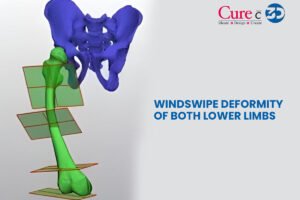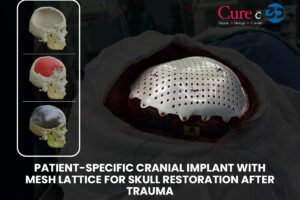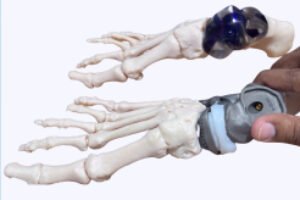Mandibular tumors often call for wide surgical resection, leading to diverse bony defects impossible to restore by conventional methods. 3D printing in jaw surgery has, in this regard, established itself as a novel tool used toward accurate surgical planning and reconstruction. This case was a representation of how a multidisciplinary team successfully performed a fibula free flap reconstruction after tumor resection with the CureWith3D team behind them.
Case Overview
The patient was diagnosed with a mandibular tumor affecting the right lower jaw. Considering the size and tumor location, the surgical team opted for segmental mandibulectomy followed by fibula free flap reconstruction, the gold standard for craniofacial reconstruction. CureWith3D collaborated with the maxillofacial surgery team in 3D medical modeling in oncology for a highly customized and precise approach to both tumor resection and mandibular reconstruction.
Stage 1: Tumor Detection and Surgical Planning
The image shows the influence of 3D printing and digital surgical planning on a customized craniofacial surgery. It is quite clear that with the help of advanced modeling and accurate anatomy from CureWith3D, the team was able to design the integrated cutting guides that facilitated the complex tumor surgery into a precise, patient-centered reconstructive model.
Using Materialise 3D, the following steps were completed:
- Virtual tumor segmentation and delineation of clean margins
- Simulation of mandibular resection planes
- Design of custom cutting guides for surgery to guide accurate bone cuts during both mandibulectomy and fibula osteotomy
- Overall Virtual Surgery Planning (VSP)
These cutting guides were designed at our lab to conform to the patient’s bone surface and were then 3D printed in-house using biocompatible, medical-grade resin. These cutting guides featured built-in slots and depth control to understand the pre-planned osteotomy lines.
Stage 2: Tumor Resection Using 3D-Printed Custom Cutting Guides
The surgeons in the operating room utilized the patient-specific cutting guide for the mandible in segmental mandibulectomy. The cutting guide was secured to the mandible in such a manner that the bone was taken out in millimeter-level precision, as accurately modeled in the virtual plan.
This approach had several advantages:
- It ensured clean oncologic margins
- Protected adjacent vital structures
- Maintained symmetry for better facial reconstruction
This represents a key advantage of 3D printing in jaw surgery—it transforms complex resections into highly controlled, pre-validated procedures.
Stage 3: Fibula Free Flap Reconstruction & Harvesting
Rebuilding the mandible required a personalized mandibular implant made from the patient’s fibula bone. A CT of the lower limb was acquired to assess fibula anatomy. Based on this the:
- Resection planes were planned to exactly match the contour of the mandibular defect
- Custom cutting guides for surgery for cutting the fibula were created and 3D printed in our in-house facility
- The fibula segments were shaped preoperatively with accuracy, which minimized the intraoperative adjustments
The fibula was then implanted at the mandibular site and fixed with the plates. The precision of craniofacial reconstruction technology ensured that occlusion, facial contours, and jaw functionality were preserved.
Outcome and Follow-Up
The patient did not experience any problems during the postoperative recovery phase. The reconstructed mandible was in perfect harmony with the remaining bone, and the face symmetry was restored.
During follow-up, it was found that the patient had normal jaw activity, performing a range of motion & proper occlusion. The surgical team noted less operative time and greater accuracy compared to traditional, non-guided methods.
Discussion
This case indicates that 3D medical modeling for oncology and Materialize 3D software enhance outcomes in complicated jaw reconstructions. Traditional freehand resection is laborious and varies from time to time. They may lead to suboptimal fit. In contrast, custom-made surgical cutting guides that are virtually planned and 3D printed for jaw surgeries ensure much greater control and predictability.
Advantages include:
- Anatomical fidelity through patient-specific modeling
- Enhanced surgical workflow
- Reduced intraoperative guesswork
- Structural & aesthetic restoration with personalized mandibular implants
Conclusion
With the help of advanced modeling and accurate anatomy from CureWith3D, the team was able to design the integrated cutting guides that facilitated the complex tumor surgery into a precise, patient-centered reconstructive model.




